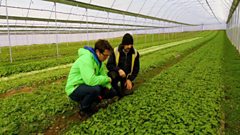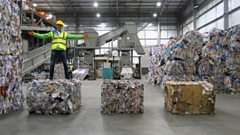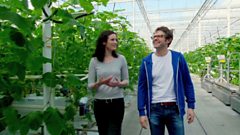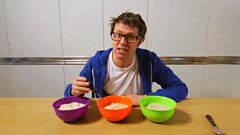
Calculating food waste and the environmental cost
Stefan Gates finds out what happens to food we discard and how to cut the amount of waste. He investigates which is more wasteful - a school dinner or a packed lunch.
In Ecomaths, Stefan Gates meets Pamela Kane from Wastewatch who gives him information on the amount of food that is wasted in the UK each year. Stefan uses the information to create a pie chart, using a real pie, to understand what are the different elements of avoidable and unavoidable food waste. The numbers are very large so he uses percentages to make comparisons. He finds out that a lot of energy is wasted and greenhouse gasses are produced when we throw food away. He demonstrates that if we stopped wasting food it would be like removing one car in five from the roads.
To find out about waste in the supply chain Stefan visits a unique supermarket in Manchester. He speaks to Dan Weston who runs the fruit and vegetable area and he shows Stefan how they minimise their food waste in a variety of ways. We see a calculation of how many tonnes of food waste is avoided each month. Stefan then meets food waste heroes from Newton Ferrers School and joins them for lunch. They show him how they measure and collect data to compare school dinners with packed lunches and find out which produces the most waste.
Duration:
This clip is from
More clips from Primary
-
![]()
Using maths to understand food journeys
Duration: 09:22
-
![]()
Using maths to recycle rubbish
Duration: 09:44
-
![]()
Understanding how rainwater can be harvested using maths
Duration: 10:10
-
![]()
How to measure temperature and save energy
Duration: 09:54
More clips from Ecomaths
-
![]()
Using maths to understand food journeys—Primary
Duration: 09:22
-
![]()
Using maths to recycle rubbish—Primary
Duration: 09:44
-
![]()
Understanding how rainwater can be harvested using maths—Primary
Duration: 10:10
-
![]()
How to measure temperature and save energy—Primary
Duration: 09:54





